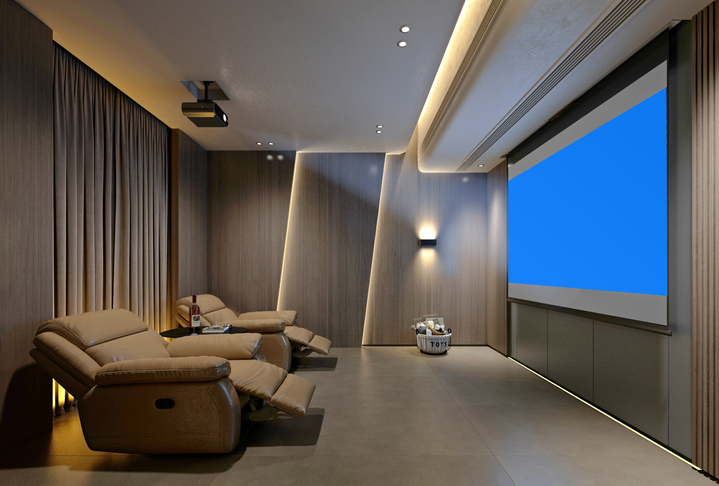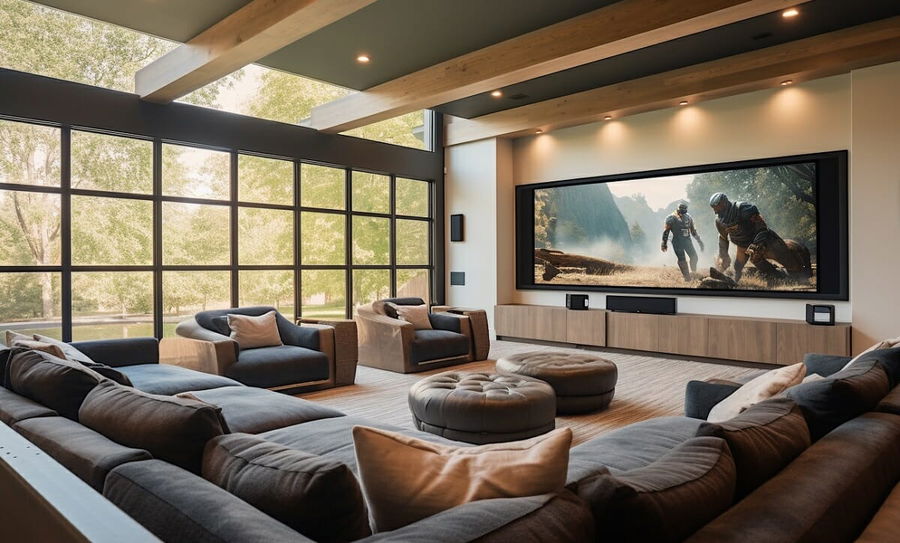Upgrade Your Living Space with Tampa Home Theater Installation
Upgrade Your Living Space with Tampa Home Theater Installation
Blog Article
Home Theater 101: Everything You Need to Know for a Cinematic Experience in the house
Creating a home theater that measures up to the motion picture experience of a business theatre includes careful factor to consider of multiple components, consisting of screen option, audio systems, and space design. Whether you are considering the suitable display dimension or the details of surround audio, understanding these principles is necessary.
Choosing the Right Screen
When establishing up a home cinema, selecting the right display can make or damage the checking out experience - home theater tampa. The screen acts as the focal point of your arrangement, affecting image quality, watching angles, and general visual. Trick variables to consider consist of display type, resolution, and dimension
First, figure out the appropriate screen size based upon your space measurements and seating distance. A basic guideline is to sit about 1.5 to 2.5 times the angled screen dimension for optimum viewing. Next off, pick between various display kinds, such as fixed-frame, motorized, or retracting displays, each offering distinct benefits. Fixed-frame screens generally supply the finest photo quality, while mechanized alternatives allow for adaptability precede use.
Resolution is one more critical variable. For a genuinely immersive experience, take into consideration a screen designed for 4K or perhaps 8K content, ensuring intensity and clarity. In addition, consider the display's gain, which impacts brightness and comparison; a higher gain can enhance illumination in well-lit rooms, while a lower gain may be preferable for darker environments.
Picking Sound Equipment
Audio equipment is an important part of any kind of home movie theater system, dramatically improving the overall watching experience. The selection of audio equipment can determine the deepness, clarity, and immersion of audio, important for creating a motion picture environment.
When selecting audio tools, take into consideration a border stereo, which typically consists of a receiver, multiple audio speakers, and a subwoofer. A 5.1 or 7.1 channel system is recommended, where the initial number stands for the audio speakers and the second the subwoofer, giving an immersive soundscape. The receiver is the heart of the system, managing sound and video signals, and should support modern styles like Dolby Atmos for a boosted spatial experience.
Quality speakers are crucial; seek versions that offer a balanced sound account with excellent bass response. Floor-standing speakers can generate richer audio, while shelf options conserve space. Additionally, think about wireless options for simplicity of setup, although wired systems frequently provide superior efficiency.

Optimum Seating Plans
Creating an optimal home cinema experience pivots substantially on optimum seating setups. The plan of seats plays an important duty in both convenience and watching high quality, straight impacting the overall motion picture experience.
First, think about the display size and viewing distance. A common standard is to place seats at a distance roughly 1.5 to 2.5 times the angled size of the screen. This makes sure an immersive experience without stressing the eyes.
Following, altitude is crucial. The back rows should be higher than the front to avoid obstructions if your seats is in a tiered style. For level seats, ensure that the front row is not as well close to the display, and that everyone has a clear line of vision.
Furthermore, consider the setup in terms of social dynamics. Team seats can boost the common experience, while specific seats might be chosen for individual viewing.

Last but not least, focus on comfort with ergonomic seating that sustains extensive watching durations. Including reclining chairs or supported seats can dramatically enhance the experience, making the home theater a favored location for both enjoyment and relaxation.
Lighting and Ambiance
Reliable lights and atmosphere are crucial parts of a properly designed home movie theater, as they dramatically affect the checking out experience. The right lights can improve the motion picture feeling, while inadequate options can interfere with it. For optimal outcomes, take into consideration a layered Look At This illumination technique that includes ambient, task, and accent lighting.
Ambient lighting offers basic lighting, ensuring that the space is not entirely dark, which can strain the eyes. Dimmer buttons are extremely recommended, enabling modifications based on the content being viewed. Task lights, such as wall sconces or flooring lamps, provides practical lighting for activities like reading or navigating the area without disrupting the total environment.
Accent illumination can be utilized to highlight building features or produce centerpieces, adding depth and rate of interest to the area. LED strip lights behind displays or along shelves can provide visit their website a refined radiance that improves the visual experience without frustrating the customer.

Wiring and Installation Tips
A well-planned circuitry setup is important for achieving ideal performance in your home movie theater system. Appropriate circuitry not only makes sure top notch audio and video signals but additionally improves the total visual of your room. Begin by drawing up your format, determining where each element will be placed, including your screen, speakers, and receiver.
When choosing wires, focus on premium, appropriately gauged circuitry to reduce signal loss. HDMI cords need to be used for video links, while speaker cord need to match the requirements of your speakers and amplifier. Select in-wall rated cable televisions to follow safety requirements and keep a tidy look.
:max_bytes(150000):strip_icc()/home-theater-room-getty-vostok-57f55aeb3df78c690f118170.jpg)
Conclusion
In recap, producing an exceptional home theater experience needs careful factor to consider of numerous aspects, consisting of screen option, audio tools, seating arrangements, lighting, and circuitry. By prioritizing these elements, a cinematic atmosphere can be effectively replicated, permitting for immersive seeing experiences that match conventional movie theater setups.
Creating a home movie theater that measures up to the motion picture experience of an industrial theater includes careful factor to consider of numerous parts, including display option, audio systems, and space format.When establishing up a home movie theater, choosing the best screen can make or damage the checking out experience. Next off, pick in between numerous screen kinds, such as fixed-frame, mechanized, or retractable displays, each offering distinct advantages. For a truly immersive experience, take into consideration a screen developed for 4K or also 8K content, ensuring intensity and quality.In recap, developing a phenomenal home theater experience needs mindful factor to consider of various aspects, including display option, audio tools, seating plans, lighting, and electrical wiring.
Report this page